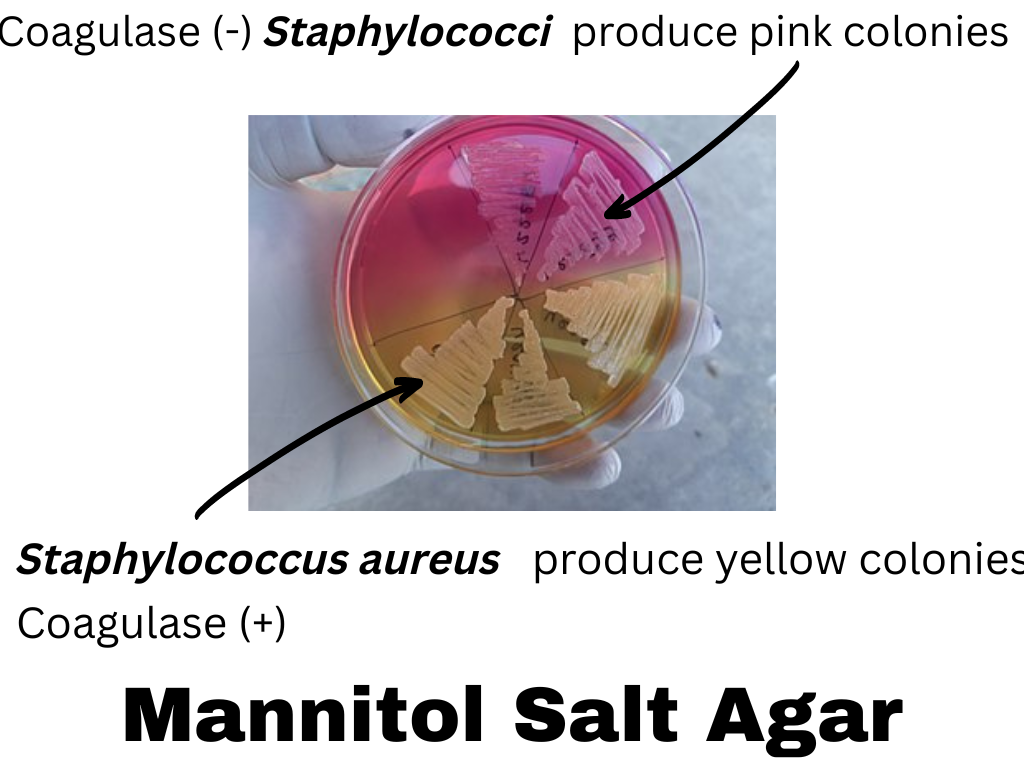Mannitol salt Agar is a selective and differential medium for the isolation and identification of Staphylococcus aureus from clinical and non-clinical samples.
As the name suggests, Mannitol Salt Agar (MSA) contains two important components. First is mannitol, which is a carbohydrate. Just like glucose, it is also a type of sugar. Mannitol is a sugar alcohol. The second ingredient present in MSA is salt. MSA contains a very high concentration of sodium chloride. There is about 7.5% sodium chloride is present in the MSA. Most bacteria cannot survive in such high salt concentrations. Only the high salt concentration tolerant bacteria will survive in the MSA medium. example Staphylococcus species
Mannitol salt agar is used for MSA test. This test is often diagnostic for the species Staphylococcus genus. As a result, Staphylococcus will often thrive on this medium. The main use of mannitol salt agar is for evaluating whether the test organism can truly metabolize or ferment mannitol.
Principle of Mannitol Salt Agar (MSA):
The high salt concentration of the MSA agar selects only those bacteria which can grow in presence of high salt environment. This medium further differentiates bacteria growing on the medium on the basis of mannitol utilization. This mannitol utilization is screened by incorporation of the pH indicator phenol red in the medium which turns the medium yellow in color when bacteria utilizes mannitol. The medium remains pink color when the bacteria doesn’t utilize utilizes mannitol. Therefore mannitol salt agar is called as selective differential culture media.

Composition of Mannitol Salt Agar (MSA)
| Beef extract | 1.0 g |
| Peptone | 10.0 g |
| Sodium chloride | 75.0 g |
| D–mannitol | 10.0 g |
| Agar | 15.0 g |
| Phenol red | 0.025 g |
| Distilled water | 1,000 ml |
| Final pH 7.4 +/_ 0.2 at 25 o C |
MSA agar is selective and differential
What makes MSA agar Selective?
This media is selective because the concentration of sodium chloride in this medium is very high (7.5%). This high salt concentration inhibits the growth of certain bacteria and allows the growth of only those bacteria which are halophilic. The term halophilic is used for those bacteria which has the ability to tolerate and grow in a high-salt environment.
The bacteria in the genus Staphylococcus are halophilic. In this way MSA agar selects only those bacteria which can grow in high salt concentrations
What makes MSA Agar differential?
MSA Agar contains pH indicator phenol red. When the pH of medium is below 6.9 at that time color of medium turns to yellow. When pH of medium is above 6.9 at that time color of the medium remains Pink.
If a bacteria grows on MSA plate and ferments the mannitol in the medium then fermentation of the mannitol will result in production of the acidic products. Due to which the pH of the medium will get lowered below 6.9. Therefore at acidic pH the medium will turn yellow color.
If the bacteria doesn’t ferment mannitol then there will be no production of acidic products and due to which the color of the medium will remain same as pink. In this way mannitol salt Agar differentiates
Watch the following video on Mannitol Salt Agar
How to interpret results on MSA agar plate?
While testing the organisms on MSA agar, we generally encounter three types of results. The color of the plate will either turn yellow, pink, or remains red.
Yellow plate after bacterial growth
When the color of MSA turns yellow it indicates that the organism can grow on the plate. It is able to ferment the mannitol present in the agar medium. Therefore, the color of the medium is changes from red to yellow. Therefore, we write the result for this organism as growth positive mannitol positive
Pinkish plate after bacterial growth
When the color of the MSA turns pinkish then it indicates that the organism has grown on the plate and the organism doesn’t have the ability to ferment the mannitol, therefore, the color remains pinkish therefore we write the result for this Organism as growth positive and mannitol negative
Red plate & No bacterial growth
Initially, the color of the MSA plate is red. If organisms doesn’t grow on the plate then the color will remain the same as red. Because of the high salt concentration organism might be inhibited from growing on the plate. Since the Organism has not grown on the first place itself therefore we are not sure whether the organism utilizes or ferments the mannitol or not therefore we write the result for this organism as growth positive and monitor N/A.
mannitol fermenting staphylococci species from mannitol non-fermenting staphylococci.
Uses of Mannitol Salt Agar (MSA)
The main use of mannitol salt agar is for determining
1. Whether the bacteria are halophilic.
2. If the bacteria is halophilic, can it ferment the mannitol?
Why certain species of staphylococcus cant ferment mannitol?
While many species of Staphylococcus are able to ferment mannitol, some species are not. This is because the ability to ferment mannitol is dependent on the presence of specific enzymes that are involved in the metabolic pathway for mannitol fermentation.
For example, Staphylococcus epidermidis, which is a common species of Staphylococcus found on human skin, is not able to ferment mannitol. This is because it lacks the enzyme mannitol dehydrogenase, which is necessary for the conversion of mannitol to fructose, the first step in the mannitol fermentation pathway.
Other species of Staphylococcus, such as Staphylococcus lugdunensis, may also lack the ability to ferment mannitol due to the absence of the necessary enzymes.
Solve MCQ on Mannitol Salt AgarFAQ on Mannitol Salt Agar
Also Read: